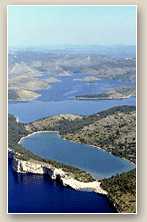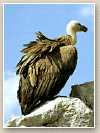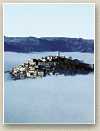|
site
map |
|
|
|
COASTAL REGIONS AND TURIST ATTRACTIONS
ISTRIA Istria is the largest peninsula in the Adriatic, with an area of 3160 square km. Istria is among the sunniest oases in Europe. The western coast rises from sea level, forming wavy highlands which stretch all the way to the Ćićarija mountain range. The eastern coast lies at the foot of the highest mountain in Istria, Učka (1396 m). Both coasts are indented with deep bays and inlets. The Croats settled there in the 7th century. Istria soon became the cradle of Glagolitic Croatian literature. The Misal from the town of Roč, 1483, is the oldest printed book in the Balkans. Istria is also the most developed tourist region in Croatia, with more than 2 million visitors each year. The most significant tourist centers are located on the western coast, though there are 11 modern marinas strewn all along the Istrian coastline. Inland are hunting grounds, medicinal baths and the famous Motovun Forest. Umag Going from north to south, the first tourist attraction on the Adriatic is the northwestern town of Umag, consisting of an old town center on a small peninsula and a newer, more modern inland development. The area around Umag is a fertile vineyard and orchard region. The town, itself, has been inhabited since Roman times. In the Middle Ages, it was part of the feudal estate of the Bishop of Trieste. The narrow, curving streets and picturesque squares are good examples of medieval architecture. Novigrad This small town lies on a tiny peninsula at the mouth of the Mirna River. The town dates as far back as the 6th century, when it called Neapolis. It expanded during the Middle Ages on an island just off the coast, which was subsequently connected to the mainland in the 18th century. The medieval structures, including circular towers, are well preserved in the old town center. Buje Thirteen kilometers from Umag lies the hilltop town of Buje. Originally, it was a pre-Christian hillfort. Later, it became the Roman settlement, Bullea. During the Middle Ages, it developed a central square, defense wall and tower. On the main square sits a 15th century Venetian Flower Gothic palace. Grožnjan The fortified medieval town of Grožnjan lies on a hilltop above the Mirna River, about 6 km. from Buje. The fortifying walls (1360 AD), main town gates (15th and 16th century) and drawbridge are partially preserved. The Renaissance town loggia was built in 1587. Annually, young musicians from the whole world come to Grožnjan to attend master courses at the summer music school organized by the International Association of Music Youth. Motovun Another hilltop town, 277 meters above sea level, is Motovun. The surrounding area produces high quality wines, while Motovun is a famous excursion destination. The settlement developed as an ancient citadel. The old town center is enclosed by a wall from the 13th century, which today serves as a promenade, offering a unique view of the surrounding area. On the main square are a 13th century campanile and the Renaissance church of St. Stjepan, built in the early 17th century. Buzet Buzet lies at the foot of Ćićarija Mountain, not far from the source of the river Mirna. The old part of the town is on an isolated hilltop. The Romans named the settlement Pinquentum. It was fortified in the Middle Ages by the Venetians, who gave it its present shape. The two town gates are well preserved, the Big Gate dating back to 1547, the Small Gate to 1592. Hum Famous as the “smallest town in the world,” Hum is situated on a slope above the river Mirna. It is enlosed by walls, towers and gates form 1562. Near the town gates stands a Romanesque-Gothic campanile. The oldest completely preseverved architectural monument in Hum, however, is the chapel of St. Jeronim at the cemetary outside the town, which dates back to the 12th century. Along the road from Hum to Roč lie eleven monuments forming the Glogolitic Road, a tribute to Croatian Glagolitic scholars. This port on the western coast is one the most developed tourist centers, not only in Istria, but on the whole Adriatic coast. Today, Poreč offers everything a modern tourist could want: rest, recreation, sport, entertainment, cuisine, shopping and, of course, beaches. Inhabited as early as the 2nd century BC, Poreč was a Roman castrum. Later it received municipium status, then became a colony in the first century AD. The Roman castrum layout is still evident in present day Poreč. Marafor square, with its three ancient temples, is the former Roman central square. The best preserved temple is that of Neptune, from the 2nd century AD. The Basilica of Euphrasius, the most valuable cultural monument still preserved, was built in the 6th century. Built in Byzantine style, it contains mosaics considered among the most beautiful in the world. Three valuable buildings remain as examples of the Romanesque style: the Romanesque house with wooden balcony, the Two Saints house (named for two figures on the front) and Kanonika (present parish), all dating from the 12th and 13th centuries. Pazin Pazin is the county seat of Istria and its economic and cultural center. The old part of town lies at the edge of the Jama precipice, with Kaštel castle. Kaštel probably dates back to the 9th century.It is the best preserved medieval castle in Istria. The newer part of town is spread across the neighboring lowland. Rovinj This port town is another of the more popular and attractive Adriatic resorts. The old town is on a small peninsula with two ports, one on each side. The peninsula is surrounded by lush, green islands and coastline, with Mediterranean and sub-tropical vegetation. The Red Island and Santa Katarina Island have beautiful beaches. Rovinj was founded on a small island off the mainland. It is first mentioned in the 8th century, as Ruvigno. It was fortified by a double wall in the Middle Ages and spread beyond those walls in the 17th century. In 1763, the island was connected to the mainland, forming the present peninsula. In the southern part of the old town is the oldest monument on Rovinj, the Romanesque heptagonal tower of the Holy Trinity, from the 13th century. At the Muntrav peninsula, south of town, there is a park with rare species of Mediterranean flora. Off the southwest coast of Istria, 6.5 km. from Pula, lie the islands of the Brijuni Archipelago. There are two larger islands, Veli and Mali Brijun, along with 12 smaller ones. They are all flat and covered with a thick layer of fertile, black soil. The mild climate allows for rich vegetation, including several tropical species, to exist. The hotels are located on the eastern side of Veli Brijun. There is also a port for ships and yachts. Inhabited even in prehistoric times, the islands came under Roman rule in 177 BC, when they were named Pullariae. A few Roman settlements were founded and the islands became a summer resort for the wealthy citizens of Pula. In 1331 AD, they came under Venetian influence, only to be abandoned later because of malaria. In 1893, the Austrian industrial magnate, Paul Kupelwieser, bought the archipelago and turned the islands into an exclusive summer resort. Hotels, baths, a golf course, hippodrome, hunting grounds and tennis courts were built. In 1983, the Brijuni Archipelago became a national park. In Verige Bay, in the eastern coast of Veli Brijun, are the remains of the luxurious Roman villa rustica from the first century AD, as well as three temples (of Venus, Neptune and an unknown deity). The most important article of medieval architecture is the rectangular tower-dungeon from the 12th century. In 1512, a citadel was built beside it. Labin Labin 5 km. fromt the east coast town of Rabac. The old part of the town is on Labin Hill, with the newer, mining settlement below. The old town is the best preserved acropolic settlement in Istria. Labin stands on the location of a prehistoric hillfort that later became the Roman town of Albona. The old town still has its medieval fortification. In front of the town gates from 1587 is the square, with town loggia from 1662 (renovated in 1777). For details and you questions please contact as here |
|
|
Real
Estate Nekretnine, Split,
Croatia tel:
+356 79010337 Terms and Conditions | Privacy statement | info@nekretnine.org |


